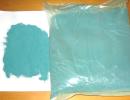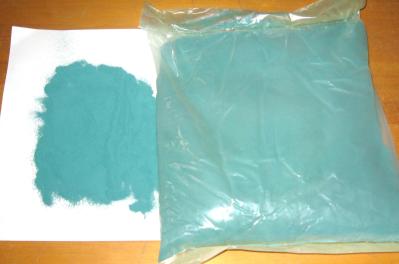
|
Copper fungicides in Kenya
|
| Some Pesticides Permitted in Organic Gardening | Contacts | |||
| General information on copper | Information Source Links | |||
| Standard procedures for the preparation and application of homemade copper products |
Some Pesticides Permitted in Organic Gardening
Organic gardeners can use certain pesticides -- chemicals that are derived from botanical and mineral-bearing sources. These chemicals may be highly toxic, but they break down more rapidly than common chemicals, such as the Sevins, Malathions and 2,4,Ds.
The use of botanical and mineral-bearing pesticides, even though some are toxic, also can be incorporated into an Integrated Pest Management (IPM) approach to growing crops. IPM relies on a variety of pest control means rather than on one product or method. The pesticides discussed below are appropriate to include in IPM programmes.
Just as the more common chemicals are given toxicity ratings -- CAUTION, WARNING or DANGER -- so are chemicals from botanical and mineral-bearing sources. "CAUTION" means low toxicity; "WARNING" means moderately toxic and "DANGER" means highly toxic. The toxicity rating for each pesticide is provided in the paragraphs below.
General information on copper
Copper fungicides were formerly accepted in organic farming provided that the number of applications was strictly followed and a proper soil amendment is observed to prevent copper accumulation in the soil, and can still be accepted with permission from the certifying authority.
In wet weather fungicide sprays should be applied as soon as the disease is observed or as soon as local experience suggests that weather conditions are favourable for disease development.
Crop scouting should be used as a guide in making a decision on whether to apply a fungicide. And when applying fungicides, safety procedures in application must be complied with, particularly, in use of protective clothing. Observe right dosage and prescribed pre-harvest intervals. Ask your local agricultural extentionist on locally registered fungicides.
Bordeaux mixture is primarily a fungicide that controls bacterial leaf spots, blights, anthracnoses, downy mildews and cankers. It also repels many insects. The compound is labelled for use on many vegetables, tree fruits and nut crops.
Bordeaux mixture, as with sulphur and lime sulphur, can be phytotoxic to plants. If applied in cool, wet weather, it may burn leaves or cause russeting of fruit.
Bordeaux mix spray
Materials needed to make a gallon mixture
- 3 ½ tbsp of copper sulphate
- 10 tbsp of hydrated lime
- 1 gallon of water (4 litres of water)
- Wooden stick
- Plastic bucket
How to prepare?
1. Add copper sulphate and hydrated lime in water. Make sure to use plastic container
2. Stir well using a wooden sick or ladle
3. Protect self from direct contact with the solution
How to use?
1. Spray plants thoroughly preferably early in the morning, in a dry and sunny day. In this way, the plants have the time to dry and the solution can not penetrate into the leaves' tissues
2. Constantly shake the sprayer while in the process of application to prevent the solution from clogging
Pest controlled
1. Flea beetles on tomatoes and potatoes
2. Anthracnose
3. Bacterial blight
4. Bacterial wilt
5. Black spot
6. Downy mildew
7.Early blight of potato and tomato
8. Late blight on solanaceous crops
9. Powdery mildew
10. Rust
Copper fungicides in the Kenya market
Copper products below listed are registered in Kenya by the Pest Control Products Board
www.pcpb.or.ke. These products are readily available in most agro-vet shops in the country. It is advisable for organic farmers to consult their respective certification agencies prior to use. According to the Soil Association (UK)
www.soilassociation.org copper is "restricted" and can be only used where the need is recognized by the Soil Association Ltd (UK). Other organic certifying agents have differing rules.
Table 1: Copper fungicides commercially available in Kenya
| Trade names of products | Active substances of products | Target pest/disease | Agent/distributor |
| AG Copp 75 WP | Cuprous oxide (equiv. to 75% metallic copper) | Leaf rust and coffee berry disease in coffee | Twiga Chemical Industries Ltd |
| Champ Flo SL | Copper hydroxide (equiv. to 24.4% metallic copper) | Botrytris and black spot in roses; early and late blight on tomato; rust, anthracnose, and angular leaf spot on French beans | Anset International Ltd |
| Champion 50 WP | Copper hydroxide (equiv. to 50% metallic copper) | Botrytris and black spot in roses; early and late blight on tomato; rust, anthracnose, and angular leaf spot on French beans; leaf rust and coffee berry disease on coffee | Anset International Ltd |
| Chem Copp 50% WP | Cuprous oxide (equiv. to 50% metallic copper) | Coffee berry disease and leaf rust on coffee | Twiga Chemical Industries Ltd |
| Cobox 50 WP | Copper oxychloride (equiv. to 50% metallic copper) | Coffee berry disease and leaf rust on coffee; blights and leaf spots on vegetables | Kijani Agencies Ltd |
| Copper Nordox | Cuprous oxide (equiv. to 50% metallic copper) | Coffee berry disease and leaf rust on coffee; blights and leaf spots on vegetables | Farmchem (K) Ltd |
| Copsap 50 WP | Copper oxychloride (equiv. to 50% metallic copper) | Coffee berry disease and leaf rust on coffee; blights and leaf spots on vegetables | Saroc Ltd |
| Cupravit 50 WP | Copper oxychloride (equiv. to 50% metallic copper) | Coffee berry disease and leaf rust on coffee; blights and leaf spots on vegetables | Kijani Agencies Ltd |
| Cuprocaffaro Micro 37.5 WG | Copper oxychloride (equiv. to 37.5% metallic copper) | Early and late blight on potato and tomato; rust, anthracnose, bacterial blight and angular leaf spot on French beans; leaf rust on coffee | Farmchem (K) Ltd |
| Cuptocaffaro WP | Copper oxychloride (equiv. to 50% metallic copper) | Early and late blight on potato and tomato; rust, anthracnose, bacterial blight and angular leaf spot on French beans; leaf rust and coffee berry disease on coffee | Farmchem (K) Ltd |
| Demildex 50 WP | Copper oxychloride (equiv. to 50% metallic copper) | Leaf rust and coffee berry disease on coffee | Biomedica Laboratories Ltd |
| Funguran OH 50 WP | Copper hydroxide (equiv. to 50% metallic copper) | Leaf rust and coffee berry disease on coffee | Amiran (K) Ltd |
| Isacop | Copper oxychloride (equiv. to 50% metallic copper) | Early and late blight on potato and tomato; rust, anthracnose, bacterial blight and angular leaf spot on French beans; leaf rust and coffee berry disease on coffee | Twiga Chemical Industries Ltd |
| Kocide DF | Copper hydroxide (equiv. to 50% metallic copper) | Leaf rust and coffee berry disease on coffee | Twiga Chemical Industries Ltd |
| Kopacide 50 WP | Copper oxychloride (equiv. to 50% metallic copper) | Leaf rust and coffee berry disease on coffee | Saroc Ltd and City Farming Ltd |
| Liquicop SL | Copper ammonium acetate (equiv. to 80g/l metallic copper) | Snthracnose and bacterial blight on beans | Hygrotech East Africa Ltd |
| Nordox Super 75 WP | Cuprous oxide (equiv. to 75% metallic copper) | Leaf rust and coffee berry disease on coffee | Farmchem (K) Ltd |
| Nordox 75 WG | Copper oxide (equiv. to 750g/kg metallic copper) | Early and late blight on tomato; rust on French beans; coffee berry disease on coffee | Farmchem (K) Ltd |
| Orionkopa WP | Copper oxychloride (equiv. to 50% metallic copper) | Leaf rust and coffee berry disease on coffee | Orion (EA) Ltd |
| Sulcop 50 DF | Copper oxychloride (equiv. to 50% metallic copper) | Fungal and bacterial diseases on flowers and vegetables | Osho Chemical Industries Ltd |
Standard procedures for the preparation and application of homemade copper products
2. Read and follow the label instructions carefully, particularly, dosage, pre-harvest intervals and safety measures. Ask for assistance from your local extension agriculture office, if unsure.
3. Spray in the early morning or late afternoon.
4. Wear protective clothing when handling pesticides and during application. Wash your hands after handling of pesticides and application. Do not eat, drink or smoke when handling and during application of synthetic pesticides including copper.
5. Do not have a direct contact with the crude extract while in the process of the preparation and during the application.
6. Make sure that you place the product out of reach of children and house pets while leaving it overnight.
7. Harvest all the mature and ripe fruits before product application.
8. Always test the product formulation on a few infected plants first before going into large scale spraying. When adding soap as an emulsifier, use a potash-based one. Gun soap (Kenya) is recommended.
Contacts
Agents / Distributors pf Copper Fungicides in Kenya
AMIRAN (K) LTD
Tel.: +254 (20) 6907000
Mobile: +254 719 095000
Email: amiran@amirankenya.com / pr@amirankenya.com
Website: www.amirankenya.com
Tel.: +254 (20) 6907000
Mobile: +254 719 095000
Email: amiran@amirankenya.com / pr@amirankenya.com
Website: www.amirankenya.com
ANSET INTERNATIONAL LTD
Tel.: +254 (20) 2726868
Email: tensa@ansetintl.com
Tel.: +254 (20) 2726868
Email: tensa@ansetintl.com
CITY FARMING LTD
Tel.: +254 (20) 551462/3
Email: cityfarm@swiftkenya.com
Tel.: +254 (20) 551462/3
Email: cityfarm@swiftkenya.com
FARMCHEM (K) LTD
Tel.: +254 (20) 2409661
Mobile: +254 722 520837 / +254 733 520837
Email: farmchem@farmchemafrica.com
Website: www.farmchemafrica.com
Tel.: +254 (20) 2409661
Mobile: +254 722 520837 / +254 733 520837
Email: farmchem@farmchemafrica.com
Website: www.farmchemafrica.com
HYGROTECH (K) LTD
Tel.: +254 154 73286
Email: (Contact) : edward@hygrotech.co.ke
Tel.: +254 154 73286
Email: (Contact) : edward@hygrotech.co.ke
KIJANI AGENCIES LTD
P.O. Box 13980-00800
Nairobi
P.O. Box 13980-00800
Nairobi
ORION (EA) LTD
Tel.: +254 (20) 2062361/2075895/2075896
Email: orion@orioneastafrica.co.ke
Tel.: +254 (20) 2062361/2075895/2075896
Email: orion@orioneastafrica.co.ke
OSHO CHEMICAL INDUSTRIES LTD
Tel.: +254 (20) 3756222
Mobile: +254 726880480 / +254 733880480
Email: oshochem@oshochem.com
Website: www.oshochem.com
Tel.: +254 (20) 3756222
Mobile: +254 726880480 / +254 733880480
Email: oshochem@oshochem.com
Website: www.oshochem.com
SAROC LTD
Tel.: +254 (20)558831/554370
Tel.: +254 (20)558831/554370
TWIGA CHEMICAL INDUSTRIES LTD
Tel.: +254 (20) 3942000/39423000
Email: info@twiga_chemicals.com
Website: www.twigachemicals.com
Tel.: +254 (20) 3942000/39423000
Email: info@twiga_chemicals.com
Website: www.twigachemicals.com
Information Source Links
- OISAT: Online Information Service for Non-Chemical Pest Management in the Tropics. www.oisat.org

 Back
Back
